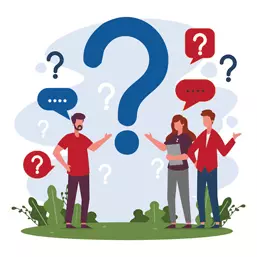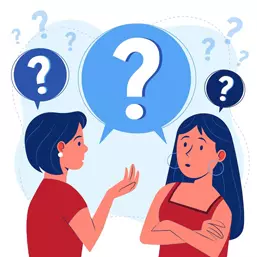
Communicating With Power Verbally
Good communication is as stimulating as black coffee, and just as hard to sleep after.
– Anne Morrow Lindbergh
Introduction
Communication skills are needed to be able to provide an excellent presentation. Without being able to verbalize your ideas and opinions there is very little chance of having a successful presentation.
We will be looking at how best speakers communicate with power through building audience rapport, being adept at listening and hearing skills, dealing with presentation questions as well as asking the correct questions, using their voice and verbal sign posts to communicate with power verbally.
How to Build Audience Rapport
Good speakers are skilled at establishing rapport with their audience. They connect with the audience and amuse as well as enlighten. How do they manage it? Based on studies of effective speakers, we may conclude that they employ a variety of verbal and nonverbal tactics to connect with the audience. Some of their useful tactics include delivering excellent images and verbal cues.

Using Effective Imagery
You’ll loose your audience quickly if your talk is filled with abstractions, generalities and dry facts. To enliven your presentation, and enhance comprehension, try using some of the following techniques:
Analogies: A comparison of comparable characteristics between diverse items may be useful in explaining and establishing connections. Product development, for example, is analogous to the process of conceiving, carrying, and delivering a baby, whereas downsizing and restructuring are analogous to an overweight individual undertaking a regimen of dieting, habit change, and exercise.
Metaphors: A comparison between otherwise dissimilar things without using the words like or as results in a metaphor. For example, “My desk is a garbage dump”.
Similes: A comparison that includes the words like or as is a simile. For example, “She’s as happy as someone who just won a lottery”.
Personal anecdotes: Nothing connects you faster or better with your audience than a good personal story. In a presentation about email techniques, you could reveal your own blunders that became painful learning experiences. Another example is – In a talk to potential investors, the founder of a new ethnic magazine might tell a story about growing up without positive ethnic role models.
Personalised statistics: Although often misused, statistics stay with people – particularly when they relate directly to the audience. A speaker discussing job searching might say, “Look around the room. Only three out of five graduates will find a job immediately after graduation”. If possible, simplify and personalise facts.
Worst and best case scenarios: Hearing the worst that could happen, can be effective in driving home a point. For example, “If we do nothing about our computer backup system now, it’s just a matter of time before the entire system crashes and we lose all of our customer contact information”.
Brief check
Use analogies, metaphors, similes, personal anecdotes, personalised statistics, as well as worst and best case scenarios instead of dry facts.
Listening and Hearing: They Aren’t the Same Thing
If listening were simple and everyone did in the same way, the role of a presenter would be considerably simpler. Today’s audiences are likely to be far more diverse. Consider the audience that will hear your talks. Being aware of such distinctions can assist you in preparing a presentation speech that minimises the possibility of misinterpretation.
To begin with, understand that listening and hearing are not the same thing.
Hearing is the act of perceiving sound by the ear. Assumingan individual is not hearing-impaired, hearing simply happens. Listening, however, is something that one consciously chooses to do. Listening requires concentration so that the brain processes meaning from words and sentences. Listening leads to learning.
This is not always an easy task.The normal adult rate of speech is 100-150 words per minute, but the brain can think at a rate of 400-500 words per minute, leaving extra time for daydreaming, or anticipating the speaker’s or the recipient’s next words.Listening skills, however, can be learned and refined.
If you want to improve yourself as a speaker, one of the most important things you must know is that the audience have very different listening styles. The disparity in listening techniques contributes to the possibility of misinterpretation.
Listening Styles
There are four types of listening styles: people, activity, material, and time.
People: The listener who is interested in people is drawn to the speaker. People-oriented listeners are interested in learning how the speaker thinks and feels about their message. For example, when people-oriented listeners hear an interview with a renowned rap artist, they are more likely to be interested in the artist as a person than in music, even if the people-oriented listener appreciates the artist’s work. If you are a people-oriented listener, you may have specific questions you want addressed, such as: Does the artist consider himself or herself successful? How does it feel to be famous? What kind of education has he or she received? Similarly, if we are listening to a doctor who reacted to the Haiti earthquake problem, we may be more interested in the doctor as a person than in the condition of circumstances for Haitians. What motivated him or her to travel to Haiti? How did he or she escape his or her usual practise and patients? How many lives was he or she able to save? We may be less concerned with the equally critical and pressing requirements for food, housing, and cleanliness in the aftermath of the earthquake.
People-oriented listeners are more inclined to pay attention to the speaker than to the message. If you are a kind of listener like this, recognise that the message is about what is essential to the speaker.
Action: Listeners that are action-oriented are mainly interested in learning what the speaker wants. Is the speaker looking for votes, contributions, volunteers, or anything else? Listening through the details, facts, and explanations with which a speaker makes his or her case may be challenging for an action-oriented speaker.
Task-oriented listening is another name for action-oriented listening. In it, the listener is looking for a clear message about what has to be done and may be less willing to listen to the reasoning behind the assignment. This is particularly true when the causes are complex. When you’re a passenger on an airline waiting to take off from the gate, for example, a flight attendant will give you a short lecture called the pre-flight safety briefing. The flight attendant does not read the results of a safety research or the seat belt requirements. The flight attendant fails to mention that the Federal Aviation Administration requires the substance of his or her speech. Instead, the attendant just instructs us to strap up so that we may go. A message about “buckling up” is more attractive to an action-oriented listener than a message on the underlying causes.
Content: Listeners who are content-oriented are concerned with the message itself, whether it makes sense, what it means, and if it is true. Many members of your classroom audience will be content-oriented listeners who want to learn from you when you deliver a speech. As a result, you have a duty to convey the truth as accurately as possible. You may highlight a point, but if you overdo, you risk losing confidence with your content-oriented audience. You may advocate for concepts that are essential to you, but if you leave out critical restrictions, you are hiding part of the truth and risk giving your audience an incorrect impression.
Assume you’re giving a speech on the suffering of orphans in Africa. If you just state that there are over 45 million orphans in Africa without explaining why, you will sound like an advertisement. In such a case, your audience’s reaction is likely to be less enthusiastic than you would prefer. Content-oriented listeners, on the other hand, like to hear well-developed material with strong explanations.
Time: People that listen in a time-oriented manner like a message that is brief and to the point. Listeners who value their time may feel irritated by sluggish delivery or extensive explanations. This kind of listener may be receptive for a short period of time and may become impolite or even angry if the speaker demands a longer period of concentration. Time-conscious listeners express their frustration by rolling their eyes, changing in their chairs, checking their mobile phones, and other improper actions. If you’ve been invited to talk to a group of middle-school pupils, keep in mind that their attention spans aren’t as lengthy as those of college students. This is a major reason why talks to young audiences must be shorter or more varied than addresses to adults.
Some of your audience members will have genuine time restrictions in the future, not just imagined ones. Assume you’ve been requested to give a speech to the board of directors of a local company about a new initiative. Most likely, the members of the board of directors are all overworked. If your speech is too lengthy and too comprehensive, time-conscious listeners will just shut you out while you’re speaking. Obviously, if time-conscious listeners begin shutting you out, they will not be hearing your message. This is not the same as being a time-conscious listener who is more concerned with the message’s duration than with its substance.
Brief check
A listening style is a general manner in which an individual attends to the messages of another person.

Dealing with Presentation Questions
Many normally incredibly skilled and confident presenters will tell you that they fear the presentation’s question and answer period. They are looking for methods to ‘avoid’ being uncomfortable. But this does not have to be the case. Managing questions during a presentation is a skill that anybody can learn.
The basic guideline of question and answer sessions is to treat your audience with the respect you would want to be accorded, and to answer their questions directly and honestly. If they’ve posed a question, it’s because they’re curious about the answer. Although this does happen, it is quite uncommon that somebody would ask you a question deliberately to trip you up. If a question is provocative, respond directly to it. Never be impolite or express your displeasure to the questioner. Maintain your point of view without compromising, and never lose your temper. This strategy might be tough to sustain, but the key is to be assertive.
Keeping Command of the Questions
The majority of individuals dread the question session because they are afraid of losing control.
This danger may be avoided with some forethought and preparation ahead of time. However, you may prevent it by recognising that each presentation is an exchange of information. It is just as important for you to know what others want to know as it is for them to hear from you.
However, if an intriguing topic begins to derail your presentation, consider stating something like: “I believe we’re going off track here. Let’s set it aside for now and talk about it later. Come find me at the conclusion, and we’ll exchange contact information.”
Alternatively: “I’d want to get started on the presentation since I may not have time to complete it otherwise, but let’s discuss this later.”
Establishing Ground Rules
You should state at the beginning of your presentation if and when you like to deal with queries – as you go along or at the finish.
Some presenters like to answer questions as they occur throughout the session. The benefit of this strategy is that any misconceptions can be addressed right away. However, there is a risk that the question could disturb or distract the speaker, or that it will create issues that will be addressed later in the presentation.Other presenters would rather answer questions at the conclusion of their presentation.
If you choose this technique, be sure to provide enough time for questions while also limiting the amount of time available. The length of time will vary depending on the style of presentation, but 10 minutes of question time should be plenty. The main benefit of this strategy is that if you speak too fast, you will simply have a longer question session: a strong incentive to speak slowly and deliberately, making sure that your audience understands everything as you go.
Managing Issues
Pay close attention to the question and, if the audience is big, repeat it to ensure that everyone has heard it. Whether you’re not sure if you understood properly, repeat it back to the questioner and double-check. Respond succinctly and to the point. If you don’t know the solution, say so and volunteer to look into it. Then make certain that you follow up. You will need the questioner’s name and email address to answer, so make sure you talk with them before they or you depart.
“I don’t know” is a perfectly fine response to certain tough inquiries, much superior than bumbling through an answer or making something up. “I’m not sure, but I’ll find out and let you know,” is much better. Relax and don’t feel obligated to know everything. If you don’t know, it’s better to be honest than to attempt to seem like you do. Trust takes time to develop, but it can be destroyed in an instant, and audiences will almost always recognise when you are not being honest.
A Different Approach: Involve Your Audience
If you’re speaking to a well-informed audience, such as a professional group, and the topic is rather broad and you don’t know the answer, try asking the room if anybody else wants to reply. You may be seated next to a global authority on that topic who would be pleased to share their knowledge with you all. You may even say: If you’ve seen someone in particular, “I saw Professor X is in the room, and I was wondering if he would mind commenting on it to avoid me from revealing my ignorance.” or “My colleague over there is more acquainted with that region than I am, so, although I don’t want to put him on the spot, maybe he’d be willing to throw some light on this?” Most people will be happy with that approach, particularly if they really know more about it than you, and it will result in a far better reaction in the room. Yes, you’re the one in charge, but you don’t know everything.
Brief check
The most essential thing to understand is that, in general, when people ask you questions, even harsh ones, it's not to trip you up, but because they truly want to know the answer.

Useful Presentation Question Types
Three types of questions are useful in a presentation; open questions, clarifying questions, and closed questions.
Open Questions: Open questions stimulate thinking and discussion or responses including opinions or feelings. They pass control of the conversation to the respondent. Leading words in open questions include:
Why, what, or how. A statement such as “describe the characteristics of the car” is really an open question. Examples of open questions include:
- Describe the style of the leader of the meeting.
- How do you feel when you hit a home run?
Asking questions is both an art and a science.Your questions in a presentation should be:
- Clear and concise, covering a single issue
- Reasonable, based on what participants are expected to know
- Challenging, to provoke thought
- Honest and relevant, eliciting logical answers
Clarifying Questions: A clarifying question helps to remove ambiguity, elicits additional detail, and guides you as you answer a question.Below are some examples:
- You said you liked apples more than oranges, why is that?
- What sort of savings are you looking to achieve?
Closed Questions: Closed questions usually require a one-word answer, and shut off discussion.Closed questions provide facts, allow the questioner to maintain control of the conversation, and are easy to answer. Typical leading words are: Is, can, how many, or does.Below are several examples of closed questions:
- Who will lead the meeting?
- Do you know how to open the emergency exit door on this aircraft?
Phrasing: To evoke an answer, your question should use phrasing that is:
- Clear and concise, covering a single issue
- Reasonable, based on what participants are expected to know
- Challenging, to provoke thought
- Honest and relevant, directing participants to logical answers.
Directing Questions appropriately: Should you direct your questions to individuals or to an entire group?When you direct a question to an individual, you:
- Stimulate one participant to think and respond
- Tap the known resources of an “expert” in the room
If you choose to direct your question to the group instead, you:
- Stimulate the thinking of all participants
- Provide participants the opportunity to respond voluntarily
- Avoid putting any one person on the spot.
It’s been said that you have between thirty seconds and two minutes to capture your participants’ attention. It’s critical to engage people from the beginning.
Using Your Voice in a Presentation
38% of the message received by a listener is governed by the tone and quality of your voice. The pitch, volume, and control of your voice all make a difference in audience perception.To successfully transmit a message, you must utilise your voice correctly. The manner you talk may either bring your words to life or drain them of their vitality.
| Characteristics | Description | Tips |
| Pitch | How high or low your voice is | Avoid a high-pitched sound. Speak from your stomach, the location of your diaphragm. |
| Volume | The loudness of your voice must be governed by your diaphragm | Speak through your diaphragm, not your throat |
| Quality | The color, warmth, and meaning given to your voice | Add emotion to your voice.
Smile as much as possible when you are speaking |
GETTING YOUR VOICE READY
Your voice, like the rest of your body, will perform best when it is properly prepared for its role. Humming scales and drinking some water before your speech, for example, may help you sound your best. You may have your own set of preferred warm-up activities. Whatever warm-up strategy you choose, be sure your voice is ready to go before you begin speaking.
ARTICULATION AND PROJECTION
To guarantee that your arguments are heard and understood, you must talk loudly and clearly enough for your listeners to hear and comprehend what you are saying. Even someone at the furthest reaches of a room should be able to understand your speech without difficulty. Projecting your voice also allows your personality to shine through.
A confident tone of voice is conveyed by a powerful voice. Speaking too quietly, muttering, or trailing off at the end of sentences might imply insecurity or shyness, undermining the power of a presentation. Whether you’re not sure if a word or phrase is important enough to express, don’t utter it. If it’s worth saying, say it with conviction.
The simpler you make it for your listeners to understand your message, the bigger the effect. Auditory obstructions will divert listeners’ attention away from the content of what you’re saying. If you utilise a microphone, bear in mind that, although it may increase decibels, it cannot give your voice power or individuality.
PACE: When a reader wants to go back and reread a phrase or paragraph, he or she may do so effortlessly. Because a listener does not have this luxury, it is the speaker’s obligation to maintain a tempo that provides listeners’ time to process the message. This speed also allows the speaker to reflect on what he or she is saying and retain a meaningful connection to the material.
VARIETY: The spice of communication is vocal variation. Tone, speed, and loudness should all be changed during a presentation. You may have gone off into your own thoughts if you’ve ever had to listen to someone talk in a monotone. It’s no accident that the term monotonous may signify both (1) a lack of pitch variation and (2) dull.
A calm and engaged speaker will naturally vary in tone, tempo, and volume. They demonstrate the speaker’s emotional connection to what he or she is saying, assisting the listener in connecting as well. Variety also makes the words more intriguing to listen to.
INFLECTION: Inflections (pitch shifts) at the conclusion of sentences are a typical source of difficulty for speakers. Inflections for questions are often distinct from those for assertions. For example, if you answered the phone and didn’t immediately hear someone on the other end, but suspected it may be Kathy, you would respond, “Kathy?” This would be a question; Kathy’s pitch would be higher towards the conclusion than at the beginning. If you asked Kathy her name, she would simply say, “Kathy.” This would be a statement; the pitch would be delivered at the conclusion of Kathy. Say it both ways and compare the results.
When attempting to convey a point, some speakers utilise inflections often associated with inquiries. If someone asked Kathy her name and she responded, “Kathy?” with an upward intonation, she would seem apprehensive, as if she were asking a question. An upward inflection at the conclusion of a sentence might also signal that there is more to come, that the speaker has not yet finished his or her present line of thought. As a result, incorrectly placed upward inflections at the conclusion of sentences might have the unintentional consequence of tying together concepts that should be different.
SILENCE: Silence may be quite effective. Silence is frequently an incredibly powerful tactic, whether used to concentrate the audience before the opening words of a speech or for emphasis after an important statement. Silence may indicate confidence; it communicates to the audience that the speaker does not feel obligated to fill space with sound in order to justify his or her position at the front of the room or at the table.
The need to avoid silence is a typical one, and it often results in the overuse of fillers such as um or uh. Resist the urge. Such fillers may swiftly sap a speaker’s vitality and convey a lack of confidence to the listener. If you’re not sure what to say next, just wait for a minute to ponder; when your next idea comes to you, continue speaking. While a second may seem like a lifetime to a speaker looking for the next word, it is just a second to the audience.
BREATHING: There is no voice without breath. Timid breathing may support only hesitant speech. Deep, calm breathing, on the other hand, serves as a basis for a powerful, adaptable speaking style.
Don’t be afraid to take a deep breath; everyone needs to breathe. You will have more options for when to take your next breath if you have adequate air, and you will avoid gasping mid-sentence or trailing off at the conclusion of a thought. Concentrate on breathing from the diaphragm. Feel your abdomen expand and contract as you inhale and exhale. This is the core of your breath control.
COMMAND: Selecting a good opener is an important way to take command of an audience. Making judicious use of certain types of remarks will endear you to the audience from the moment the program starts.
- A dramatic story
- A reference to a current or well-known news story
- A personal experience
- A rhetorical question
- A historical event
Adventure, either past or present
Brief check
-To successfully communicate, you must utilise your voice. The manner you talk may either amplify or weaken the impact of your words.
-Knowledgeable speakers provide verbal signposts to indicate when they are previewing, summarising or switching directions.
Verbal Signposts
Speakers must remember that listeners, unlike readers cannot control the rate of presentation or flip back through pages to review main points. As a result, listeners get lost easily. Knowledgeable speakers help the audience recognise the organisation and main points in an oral message with verbal sign posts. They keep listeners on track by including helpful previews, summaries and transitions such as the following –

Previewing
“The next segment of my talk presents three reasons for …”.
“Lets now consider the causes for …”.
Summarising
“Let me review with you the major problems I’ve just discussed…”.
“You see, then, that the most significant factors are…”.
Switching Directions
“This far we’ve talked solely about…; now let’s move to…”.
“I’ve argued that …and…, but an alternate view holds that…”.
You can further improve your presentation by including appropriate transitional expressions such as first, second, next, then, therefore, moreover, on the other hand, on the contrary, and in conclusion. These expressions lend emphasis and tell listeners where you are headed.
Practical Application
Mark was delivering training in the form of a lecture. Despite the fact that this was not his favourite kind of training to provide, it was something that the firm had expressly requested of him. In order to break up the monotony, he took breaks at regular intervals to ask questions. “I have two inquiries,” he said. Unfortunately, one of these is a rhetorical question.” This elicited just one or two brief chuckles from the audience. Then he asked the audience, “When a new client calls your firm for the first time, how would you describe the experience?” The response to Mark’s query was a deafening silence.
Mark could sense that so far his engagement with the audience wasn’t really working out so he decided to ask more open-ended questions. He said, “If you were a client calling for the first time, what would you expect from the person on the other end of the line?” he then gave a little pause for the audience to contemplate. The group was put to the test by this straightforward open-ended question. Slowly, but steadily, the group began to provide serious responses and participate in a conversation. Mark was successful in his mission to engage the group and generatehonest, reasonable responses from them.





